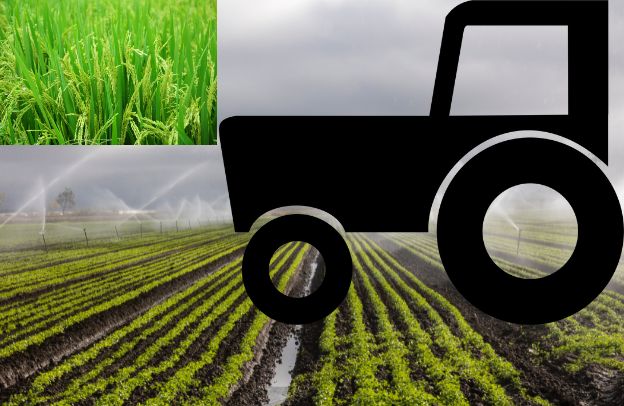How Technology is Improving The Production of Rice in Africa

Imagine this: you, an African diaspora entrepreneur, see Africa’s vast farmlands, envisioning them not just as fields but as golden opportunities. The continent’s potential in agriculture, particularly in rice production, is massive. Yet, each year, Africa imports an astonishing amount of rice; over 16 million metric tons annually costing billions of dollars. You wonder: why? And more importantly, how can you change this narrative, empower local communities, and turn rice production into a thriving, self-sustaining sector? The answer is technology, collaboration, and continuous learning.
Want to learn more about storytelling? Start by downloading the first chapter of The Storytelling Mastery.
Welcome to a journey of not just feeding the population, but creating wealth, resilience, and a lasting legacy through agribusiness.
The State of Rice Production in Africa
Rice is a staple food for millions across the continent. From Nigeria to Senegal, from Kenya to South Africa, it’s a part of everyday life. But here’s the challenge: Africa’s production lags far behind its consumption. In 2021 alone, the continent produced only about 19 million metric tons of paddy rice, far below its consumption levels.
In an article titled ”Rice Production in Africa: Current Situation and Issues” by the Food and Agriculture Organization, it is highlighted that rice serves as a staple food across numerous African nations and forms a significant portion of the diet in many others. Over the past three decades, the demand for rice has risen steadily, underscoring its growing importance in the food security strategies of many countries.
However, with few exceptions, most African nations struggle to meet domestic rice demand through local production, leading to heavy reliance on imports. Of the 11.6 million tonnes of milled rice consumed annually in Africa (FAO, 1996), 3.3 million tonnes—approximately 33.6%—are imported.
Notably, 21 out of 39 rice-producing countries import between 50% and 99% of their rice needs. Regionally, North Africa has the lowest reliance on imports (1.7%), while Central Africa imports the highest proportion (71.7%).
The continent’s inability to achieve self-sufficiency in rice production stems from critical constraints within the rice sector. Addressing these challenges is essential to reduce dependency on imports, curb the economic strain of foreign currency expenditures, and harness the untapped potential of local production to meet the ever-increasing demand for rice.
This heavy reliance on imports drains national economies and leaves millions vulnerable to global price shocks the winds of change are blowing. Technology, when adopted strategically, holds the power to turn Africa’s rice sector around. And your involvement—through investment, collaboration, and storytelling—can accelerate this transformation.
Bridging the Gap with Innovation and Collaboration
The good news is that the solutions to these challenges are within reach. They require a combination of innovative approaches and collaborative efforts among governments, businesses, NGOs, and local communities. Here’s how we can address these challenges:
- Investment in Infrastructure: Governments and private sector partners can work together to build better roads, storage facilities, and efficient water management systems. Public-private partnerships and international aid can accelerate infrastructure development, ensuring rice reaches markets more efficiently and with less waste.
- Improved Water Management Techniques: Adopting sustainable water management practices, such as drip irrigation and rainwater harvesting, can optimize water use. Innovative technologies, like smart irrigation systems that use sensors to monitor soil moisture levels, can help farmers use water more judiciously.
- Sustainable Land Management: Promoting crop rotation, agroforestry, and organic farming practices can restore soil health and improve productivity over time. Education and training programs focused on soil health can empower farmers to adopt practices that maintain soil fertility.
- Access to Finance and Resources: Financial institutions and fintech companies can offer low-interest loans and microcredit tailored for farmers to access modern farming techniques and technology. Additionally, cooperative farming models can enable farmers to pool resources and share the costs of investing in advanced equipment and sustainable practices.
Collaboration for Progress
The path forward involves a collective approach where all stakeholders contribute to overcoming the barriers in rice production. From local farmers sharing best practices to government bodies implementing policies that support sustainable agriculture, collaboration can spark meaningful change.
Partnerships with research institutions can drive innovation in seed development and pest control, making farming more resilient. By coming together, we can harness the power of innovation to build a more robust and sustainable rice production sector that benefits not only farmers but entire communities and economies.
Technological Innovations Transforming the Sector
When you think of tech, you may imagine apps, smartphones, or robotics in Silicon Valley. But in Africa’s rice fields, tech takes on a new form; one that blends tradition with innovation. Here are some examples making waves across the continent:
- Precision Agriculture: Imagine drones flying over rice paddies, collecting data on crop health, and optimizing inputs like water and fertilizer. GPS-guided tractors plow fields with millimeter precision, reducing waste and maximizing yields.
- Modern Seed Varieties: High-yield, pest-resistant rice varieties like those developed through AfricaRice’s breeding programs have empowered farmers with greater output per hectare.
- Precision I No more wasting water. Technologies such as drip and pivot systems ensure every drop counts, boosting yields while conserving resources.
The ResearchGate article “The Role of Precision Agriculture in Food Security” emphasizes how precision agriculture (PA) leverages information technology to optimize crop and livestock production, positioning it as a valuable tool to enhance global food security. PA has the potential to boost productivity, improve resource efficiency—such as the use of pesticides, fertilizers, water, and labor—stabilize production, and reduce agriculture’s environmental impact.
However, the adoption of PA varies significantly based on factors like farm size, crop types, livestock raised, access to technical support, and the operator’s education and experience. While PA offers substantial benefits to its adopters and society, its implementation remains limited to small, low-mechanization farms—often found in regions most affected by food insecurity. Consequently, many farmers who cannot access this technology face a growing disadvantage.
According to the Food and Agriculture Organization (FAO), food security rests on four pillars: availability, access, utilization, and stability. Unlike previous agricultural innovations focused solely on production, PA’s information-driven approach enables better decision-making and adjustments throughout the entire food supply and demand chain.
This unique capability makes PA a transformative tool for addressing the multifaceted challenges of food security, provided its adoption becomes more widespread and inclusive.
You’re not alone in this quest; African governments, NGOs, and even private companies are stepping up. Countries like Senegal and Nigeria have seen tangible benefits from hybrid seed distribution and irrigation projects. Take, for instance, Mali’s success in precision agriculture, which led to a 25% increase in productivity.
See also Overcoming Challenges In Rice Production In Africa: Innovative Solutions
Building Team for Agribusiness Success
You might be wondering, “What can I do to make a difference?” As a member of the African diaspora, you are in a unique position to drive change in the agribusiness sector. Your global perspective, connections, and resources can play a pivotal role in transforming the industry from seed to shelf. Here’s how you can leverage your strengths and contribute meaningfully:
- Invest in Infrastructure: Partner with local governments, NGOs, and entrepreneurs to build and enhance transportation networks, storage facilities, and supply chain systems. Improved infrastructure reduces costs, minimizes waste, and makes it easier for farmers to reach broader markets.
- Bring Knowledge Home: Use your expertise and network to organize training programs that teach modern agricultural practices, financial literacy, and business skills. Equipping farmers with practical knowledge boosts productivity, fosters self-reliance, and empowers local communities.
- Empower Women and Youth: Actively support the inclusion and leadership of women and young people in agriculture, where they are often the backbone of local economies. Programs that foster entrepreneurship and training for these groups can strengthen communities and create sustainable growth.
AClasses Media is an ideal partner for you and others looking to build a foundation of business and leadership skills essential for agribusiness success. Whether you’re looking to refine your storytelling abilities to market products effectively, enhance your leadership capabilities, or master other essential business skills, AClasses Media can guide you every step of the way. By investing in yourself and others, you can help create a more dynamic, resilient, and impactful agribusiness sector in Africa.
The Power of Storytelling in Agribusiness Marketing
Data and technology are essential for driving progress, but it is emotions that truly influence markets, shape partnerships, and inspire change. That is why storytelling is your most powerful tool.
Imagine this: You visit a farmer in northern Nigeria who has adopted a new hybrid rice variety that has doubled his yields. As he shares his story, you learn that the extra income he earned enabled him to send his daughter to university—a life-changing opportunity. When you share this story with the world, it’s more than just a statistic; it’s an authentic, emotional connection that attracts not just interest, but investment, collaboration, and trust.
Storytelling bridges the gap between data and human experience. It creates connections that numbers alone cannot. Use your journey, your challenges, and your victories to craft narratives that resonate. These stories humanize your brand, making it relatable and memorable. They evoke empathy and action, drawing in your audience and encouraging others to support your vision.
A powerful narrative does more than just elevate your brand; it fosters a deeper sense of community, especially within the diaspora. Your stories can spark conversations, build relationships, and cultivate a spirit of shared purpose.
In agribusiness, a collaborative approach means pooling resources, exchanging experiences, and leveraging knowledge to build a robust network. This network doesn’t just survive; it thrives together, driving innovation and sustainable progress that extends beyond business into the heart of communities.
When you use storytelling as your secret weapon, you’re not just promoting a brand; you’re creating a movement that connects people, inspires action, and paves the way for long-lasting change.
See also From Farm to Table: Crafting Compelling Narratives in Agribusiness
Success Stories Fueling Change
Success breeds success. When you see what’s possible, you’re inspired to do more. Here are a few examples:
- Mali’s Rice Revolution: Through precision farming and training, yields in several regions soared, showcasing what happens when tradition and innovation collide.
- Nigeria’s Hybrid Rice Program: With national support and private sector backing, hybrid seeds with superior yields and resilience are changing the game, reducing the country’s dependency on imports.
Each story offprint for scaling initiatives continent-wide.
Continuous Learning: The Foundation for Growth
Never stop learning. In a world where markets evolve rapidly, technologies advance at an unprecedented pace, and best practices shift constantly, continuous education is not just beneficial; it’s essential.
Programs like those offered by AClasses Media provide you with the tools and knowledge to stay ahead of the curve and make your business more adaptive and resilient. Remember, learning isn’t just about personal growth—it’s about keeping your business competitive, relevant, and poised for long-term success.
- Business Skills: Gain mastery over crucial business aspects such as negotiation, finance, and strategic planning to navigate global markets effectively. Understanding how to make sound financial decisions, negotiate better deals, and develop strategies that work in diverse economies can set you apart as a leader who is equipped to handle challenges and seize opportunities.
- Self-Improvement: Enhance your leadership, resilience, and communication skills to inspire and motivate your team. Strong leadership fuels team performance, drives innovation, and creates a positive ripple effect within communities. Resilience ensures you stay the course in the face of adversity, while effective communication fosters transparency and trust, leading to better collaboration and stronger partnerships.
- Innovation and Adaptability: Equip yourself with skills to identify new trends, adapt to change swiftly, and leverage innovation for growth. This includes learning about new technologies in agribusiness, such as precision farming, blockchain for supply chain transparency, or AI-driven data analytics for market forecasting.
ACourses like those from AClasses Media empower you to develop not just theoretical knowledge, but practical skills that can be directly applied to your business operations.
By investing in continuous education, you position yourself as a forward-thinking leader ready to embrace challenges, leverage new opportunities, and lead your business and community toward growth and sustainability.
See also AClasses Media: Your Ultimate Learning Platform for Business and Self-mastery
The Road Ahead: Collaboration and Commitment
You are not just building a farm; you’re building a legacy that can transform lives and uplift entire communities. This journey isn’t one you take alone—it requires collaboration, continuous learning, and a commitment to giving back.
Imagine a continent where self-sufficiency thrives, where communities are empowered, and where pride and opportunity replace dependence and stagnation. Achieving this vision starts with concrete actions:
- Partner with farmers, NGOs, governments, and diaspora networks: Collaborative efforts amplify impact. By partnering with local farmers, you strengthen supply chains and create sustainable farming practices. Engaging NGOs and governments can provide the support needed for infrastructure and policy advocacy. Building bridges with diaspora networks expands access to global markets, investment opportunities, and innovative ideas.
- Embrace lifelong learning to keep pace with innovation: Agriculture, like any industry, is constantly evolving. To remain competitive and effective, embrace continuous education and training. Stay informed about emerging technologies such as precision agriculture, smart irrigation, and AI-driven data analysis.
- Harness the power of storytelling to create a brand that resonates with people and moves markets: Your journey, the stories of local farmers, and the impact of your work are more than facts—they’re the heart of your brand. Use storytelling to connect emotionally with your audience, showcasing how your initiatives improve lives, protect the environment, and contribute to economic growth.
The path to building a legacy is not simple, but with strategic partnerships, an unwavering commitment to learning, and the power of authentic storytelling, you’re setting the stage for a new era of opportunity and growth. Your actions today have the potential to reshape the future, ensuring that agriculture in Africa is a catalyst for prosperity and empowerment for generations to come.
See also Collaborations and Networking: How to Build a Creative Ecosystem That Can Fuel Your Business
Conclusion: A Call to Action
Africa’s journey to rice self-sufficiency starts with you. It begins with bold steps, strategic collaborations, and a commitment to making a difference. You hold the power to transform a staple crop into a symbol of resilience, prosperity, and unity. So, what’s your next move? Join hands with the diaspora, invest in Africa’s rice sector, and grow a story worth telling. Together, you’ll plant seeds that feed the continent and generations to come.
Want to learn more about storytelling? Start by downloading the first chapter of The Storytelling Mastery.






